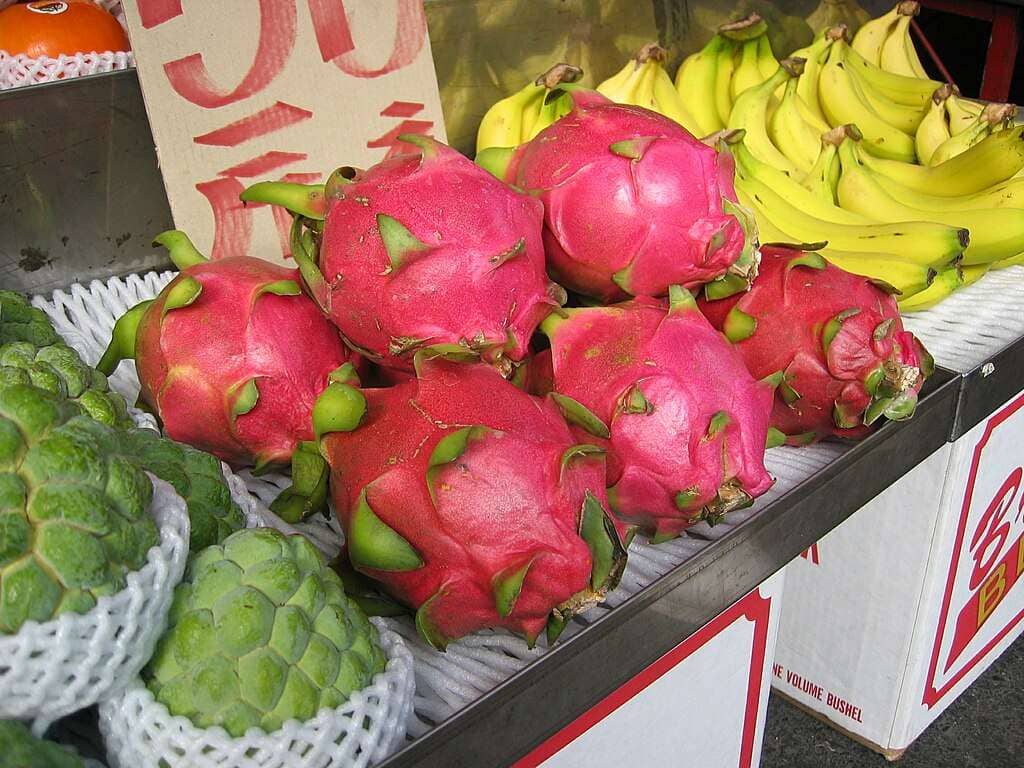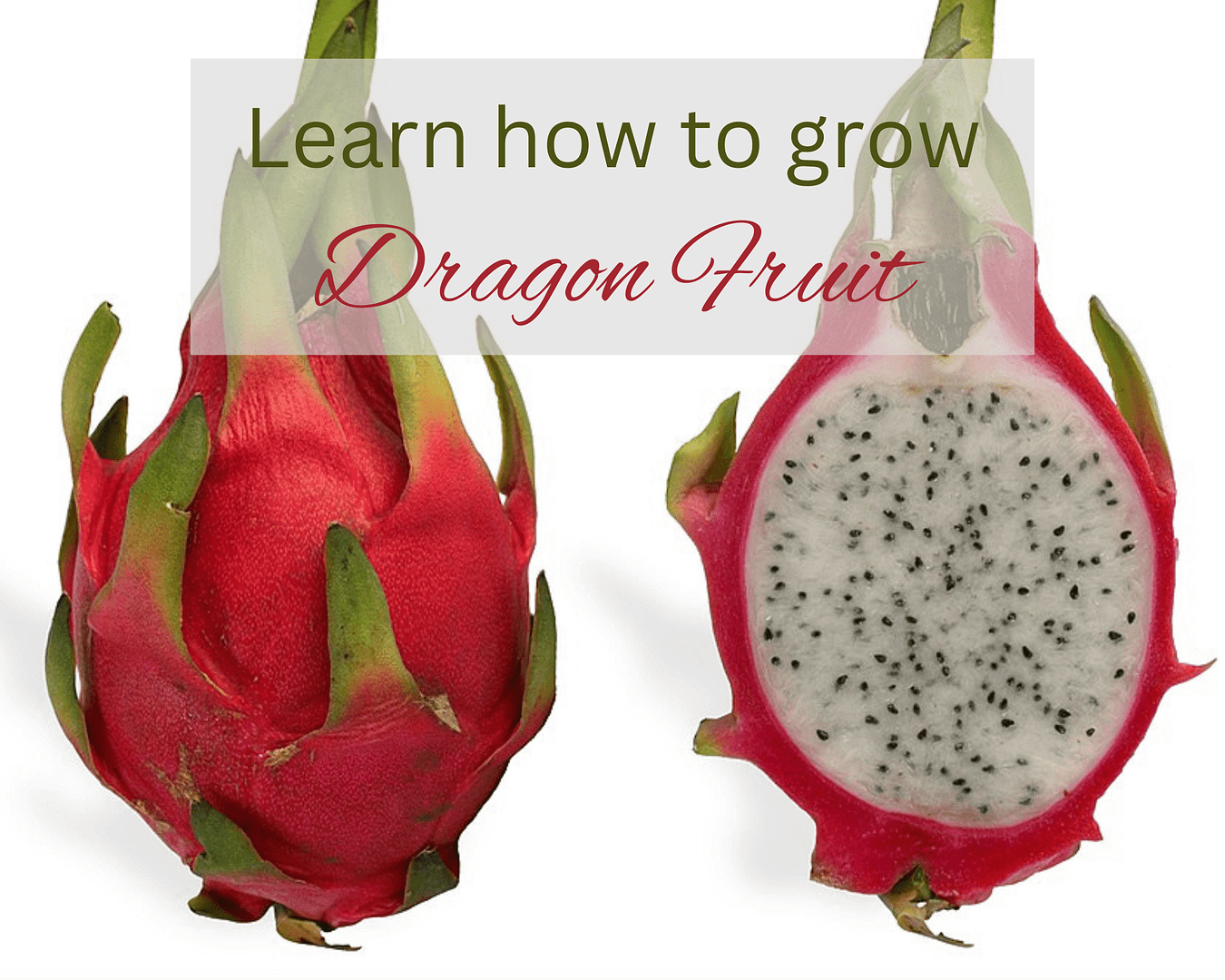This post may contain affiliate links. As an Amazon Associate we earn from qualifying purchases.
Learn how to grow dragon fruit, from propagation to harvest and beyond!
Dragon fruit, also known as pitaya, is an exotic fruit that has taken the culinary world by storm. It is also pretty amazing to look at; it’s almost like something that might’ve fallen to Earth from outer space.
With its striking appearance, unique taste, and numerous health benefits, this tropical gem has become popular for food enthusiasts and health-conscious individuals.
Today we take a deep dive into everything dragon fruit related.
What is dragon fruit anyway?

Dragon fruit is the fruit of several members of the cactus family of plants. You may also hear it called pitaya, which, in reality, isn’t a blanket term for all dragon fruit.
Confused?
Most folks are. Let’s see if we can clear it up for you.
The fruit of two genera in the cactus family are commonly called “dragon fruit.” The fruit of the cactus in the Stenocereus genus is also known as “pitaya.”
The fruit of the cactus in the Selenicereus genus is also dragon fruit, known commonly as “pitahaya.”
These cactus species came to us centuries ago from Mexico and Central America. They have since traveled the globe, delighting gardeners, those who value its nutritional properties, and, of course, fruit lovers across the globe.
Appearance and taste
We’ve already pointed out the dragon fruit’s other-worldly appearance, with psychedelic-colored, scaly skin. But there’s taste to consider as well.
Some cultivars are sour while others are sweet. Some have white flesh, others have yellow or red.
Bite into a dragon fruit and you might describe the taste as similar to a pear. If you taste nothing, you haven’t let it ripen enough.
 Nutritional value of dragon fruit
Nutritional value of dragon fruit
Dragon fruit is not only tasty but also packs a nutritional punch. It is a rich source of vitamin C, antioxidants, and dietary fiber, which help boost the immune system and aid in digestion.
Also, dragon fruit contains essential minerals like iron, calcium, and phosphorus, contributing to bone health and general well-being.
Researchers have conducted studies on animals to determine just how good dragon fruit is at keeping us healthy, with mixed results.
The bottom line? “Dragon fruit is a low-calorie fruit that contains less sugar and fewer carbs than many other tropical fruits. It may offer some health benefits, but human studies are needed to verify this,” cautions Franziska Spritzler at HealthLine.com.
Most popular dragon fruit cultivars
As mentioned earlier, several cultivars of dragon fruit exist, each with its own unique characteristics. Some of the most popular ones include:
- Selenicereus undatus (White-fleshed dragon fruit): This variety has a bright pink outer skin with white flesh inside. It is the most common type found in supermarkets and is appreciated for its mild and slightly sweet taste.
- Selenicereus costaricensis (Red-fleshed dragon fruit): With a bright red outer skin and red or magenta flesh inside, this cultivar offers an intensely sweet flavor compared to the white-fleshed variety.
- Selenicereus megalanthus (Yellow-fleshed dragon fruit): This variety has a yellow outer skin and white flesh with small black seeds. It is known for its delicate flavor, often described as a mix of banana and kiwi.
 Dragon fruit propagation
Dragon fruit propagation
Dragon fruit is propagated through seeds, cuttings, or tissue culture. While growing from seed is possible, the plant will take several years to produce fruit. As a result, most commercial growers prefer vegetative propagation using cuttings to maintain the characteristics of desirable cultivars.
Since we would prefer our dragon fruit sooner rather than later, propagating from cuttings is what we’ll discuss here.
Step 1: Choose the growing location. It should be an area that receives as much full sun as possible, at least six hours. The exception to this rule is our gardening friends in hot, dry climates (hello Arizona!). In this case, choose a site that receives shade in the afternoon.
Step 2: Get the soil ready before doing anything else. Ensure that it drains freely. If it doesn’t, amend it by mixing 2 to 4 inches of aged compost into the top 4 inches of garden bed soil.
Use a garden fork or a spade to mix the compost into the soil to a depth of 6 inches.
Step 3: Ensure that the mother plant from which you’ll take the cutting is mature and healthy. Use sharp and disinfected pruning shears or a knife to cut a “branch” from the cactus. and cut on the diagonal, a 12-inch cutting. The diagonal cut is more for the mother plant’s benefit as it helps keep rainwater from pooling on the fresh cut.
Step 4: Cut the dragon fruit cutting into three to five pieces. Make sure you keep track of what direction is “up” for each cutting—when you plant them, you’ll need to plant them upright to allow them to grow properly.
Step 5: Allow the cut ends of the cactus cuttings to callus over by placing them in a warm, dry location. This may take from one to two weeks and you’ll know it has callused when the cut edges appear to be scabbed.
Step 6: Plant each cutting by placing the base an inch or two beneath the soil and pressing the soil around it to keep it secure and upright. Make sure you plant the cutting in the same direction the original branch was growing—the end closer to the base of the original dragon fruit plant should be the end planted in the soil, and the end closer to the tip of the original branch should be poking out of the soil surface.
Step 7: Now comes the tricky part. Some growers recommend watering the dragon fruit cuttings immediately after planting. We have better luck avoiding rot by leaving them in dry soil for a week or two. After that watering, we allow the soil to dry again before repeating the process.
As we said, not everyone chooses this method, so you decide what works best for you. We can tell you, not watering a newly planted cutting goes against all of our nurturing instincts so it’s not easy!
Keep in mind that too much water may cause root rot. It may take up to three weeks for you to see new growth.
How to grow dragon fruit in pots
It is possible to start the dragon fruit cactus indoors. Choose a pot that has drainage holes in the bottom and fill it with light, fluffy cactus potting soil.
Treat the cuttings as you would if you planted them in-ground and transplant them to a larger pot when they begin to show new growth.
Whether growing in-ground or in pots, you may need to provide support for the cuttings because they have a tendency to flop over, at least until they have roots. As it grows, you’ll want to switch out a stake for a trellis or larger stake to support the plant.

Ongoing care of dragon fruit cactus
Sunlight and water requirements
Remember, dragon fruit hails from regions with tropical and subtropical climates. Give the plant lots of sunlight (at least six hours per day).
Water the dragon fruit cactus consistently but never allow it to sit in soggy soil. It will need more water when it is in bloom and during fruit production.
Soil pH and fertilizer
Dragon fruit plants prefer slightly acidic to neutral soil with a pH between 6.0 and 7.0. If your soil tests higher than this (and it is critical to test your soil if you are in doubt), you can bring it down by adding organic material to the soil. Check the resources section at the end of this post for a pH meter that we recommend.
Another method to try is the use of fertilizers marketed to acidify soil. These typically contain elemental sulfur (the label may say ammonium or aluminum sulfate). Dilute the suggested application strength to half of what is recommended on the label.
If your soil is within the preferred pH range for dragon fruit, use 10-10-10 fertilizer, while the plant is actively growing, according to label instructions. Reapply every three months.
Prefer an organic fertilizer? We do too and you’ll find it listed in the Resources section at the end of this blog post.
Pruning and maintenance
Pruning is essential for maintaining the health and productivity of dragon fruit plants. Trimming back excessive growth and removing dead or diseased areas will improve airflow and reduce the risk of fungal diseases. Additionally, pruning can encourage new growth and increase fruit yield.
The plant can be trained onto a trellis or support structure to keep it off the ground, making it easier to manage and preventing damage from pests or rot caused by contact with the soil.
Common dragon fruit pests and diseases
While dragon fruit plants are generally resilient, they can be susceptible to certain pests and diseases. Common pests include mealybugs, aphids, and fruit flies, which can be controlled using commercial insecticidal soaps or natural predators.
Common diseases of dragon fruit include stem rot. Either fungal or bacterial, stem rot can be identified by “… either a yellowing and rotting of the stem and blades,” if caused by bacteria or reddish-brown lesions, with the center of the lesions becoming white if a fungus is attacking the plant, according to Eulogia Bohol at WikiFarmer.com.
Unfortunately, there is no cure for the fungal disease and, once infected, the affected plant parts should be removed. Spraying the plants with copper fungicide can prevent it.
Proper soil drainage and adequate spacing between plants, along with good airflow, can help prevent these issues. Fungicides may be used as a preventive measure or to treat early signs of disease.

Finally, it’s time to harvest the dragon fruit
Dragon fruit plants typically start to produce fruit within one to two years after planting. The fruit is ready to be harvested when it reaches its full color and size. To check for ripeness, gently press the skin—if it gives slightly, the fruit is ready to be picked.
Using pruning shears, cut the fruit from the plant, leaving a short stem attached. Handle the fruit with care, as the outer skin is delicate and can bruise easily.
Preserving dragon fruit
Dragon fruit can be enjoyed fresh or preserved for later use. To preserve dragon fruit, it can be frozen, dried, or turned into jams and jellies.
Freezing the fruit is a simple method—just peel and cube the flesh, then store it in airtight containers or freezer bags. These chunks come in handy when you want a refreshing smoothie or to create dragon fruit lemonade.
We checked the prices across a number of supermarkets this morning. Red dragon fruit is priced between $4.62 and $6.00, (yes, per fruit) depending on retailer.
The yellow? It’ll cost you dearly – up to $10.00 in some locations.
Save your money and grow your own dragon fruit!
BONUS! 3 dragon fruit recipes you simply MUST try!
Resources
White flesh dragon fruit cutting
Red flesh dragon fruit cuttings
Yellow flesh dragon fruit cuttings
Organic compost
Garden fork
Spade
Pruning shears
Cactus potting mix
Soil pH meter
Organic elemental sulfur
Organic fertilizer for dragon fruit
Organic insecticidal soap
Copper fungicide spray




